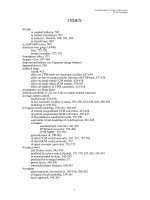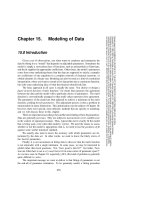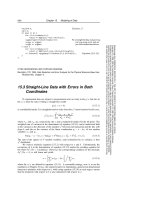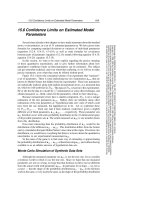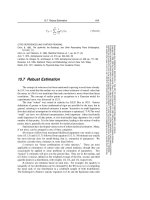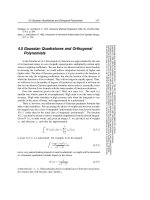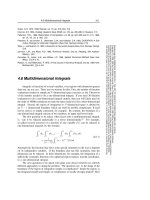Tài liệu Physics of Balance & Weight Shift ppt
Bạn đang xem bản rút gọn của tài liệu. Xem và tải ngay bản đầy đủ của tài liệu tại đây (1.84 MB, 22 trang )
Physics of
Balance &
Weight Shift
This tutorial helps you create realistic
poses for your characters by showing
you the basic principles of balance.
You’ll also see how weigh shift affects
a pose and what makes an action pose
dynamic.
“We come into this world head first
and go out feet first; in between it is
all a matter of balance.“
Paul Boese
January 2011
© 2011 Alejandro L. Garcia
Creative Commons Attribution-
Noncommercial-Share Alike 3.0
United States License
2 Animation Physics — Balance & Weight Shift
► Establishing balanced poses for your characters is an
important stage in the design process. You don’t want a
standing character to look like it’s about to tip over (unless
it’s supposed to).
So how do you know that a character’s pose is in balance?
Consider these various poses; which ones are in balance
and which ones are not. How can you tell the difference?
Is the character’s weight correctly refl ected in the pose?
Character Design
Understanding the principles of balance is equally important
in visual development and for animation since stationary
characters and objects in a scene need to be in balance.
The principles of balance also
apply to moving characters,
which need to be in or out of
balance in a way that’s consis-
tent with how they’re moving.
Balance is not the same as symmetry and
symmetry is not the same as balance.
3 Animation Physics — Balance & Weight Shift
► The average position of an object’s weight distribution is
called the center of gravity (CG).
For simple, solid objects, such as a baseball or a brick, the
center of gravity is located at the geometric center.
If an object does not have a uniform weight distribution
then the center of gravity will be closer to where most of
the weight is located.
For example, the center of gravity for a hammer is located
close to where the head connects to the handle.
The center of gravity can be located at an empty point in
space, such as the center of a hollow ball.
The center of gravity can even be completely outside of an
object, such as for a donut or a curved banana.
Center of Gravity
X
X
X
X
X
X Handle CGX
X Hammer CG
Head CG
Note: Center of gravity
is the same as the center of
mass when the strength of
gravity is constant, as it is on Earth.
4 Animation Physics — Balance & Weight Shift
► One way to locate an object’s center of gravity is by
means of suspension. An object always hangs such that the
CG is directly below the point of suspension.
Suspension from a single point is not enough to locate the
center of gravity, it only tells you that the CG is somewhere
below the point of suspension. But hanging the object from
a second point lets you to fi nd the CG by triangulation.
X
Locating the CG by Suspension
The center of gravity of the hammer is
located inside the handle close to the
hammer’s head.
These photos show a doll, in various action
poses, suspended from a variety of points.
Notice how the position of the CG depends on
the orientation of the arms and legs.
The doll has a hollow head so its CG is located a
bit lower in the body than for a human.
With the arms raised the CG
shifts higher in the body.
In this U-shaped pose
the CG is located out-
side the body, at about
the height of the pelvis.
X
X
5 Animation Physics — Balance & Weight Shift
X
The center of gravity is proportionally closer
to where most of the weight is located, as in
the hammer shown here.
Locating the center of gravity by pivoting on
a support is based on the same principle
as a balance scale. The scale will balance
when the leverage is the same on each side.
► Another way to locate an object’s center of gravity is by
means of support. An object will balance on a pivot point
when the CG is exactly above or below that pivot point.
If the pivot is below the CG then the balance is unstable; any
slight rotation causes the object to tip and fall off the pivot.
If the pivot is above the CG then the balance is stable and
a slight rotation makes the object just swing back and forth.
Locating the CG by Support
Question: What’s the easiest
way to balance a donut on your fi nger?
Answer: Put your fi nger through
the hole so that the CG, located at the
center of the donut, is below your fi nger.
X
X
The toy bird above balances stabily on the tip of its beak.
The wing tips are weighted so that the center of gravity is
located just below the bird’s beak.
Unstable
Stable
X
1 foot
4 feet
40 pounds
10 pounds
2 inch
6 inch
XX
X Hammer CG
30 ounce
Head
10 ounce Handle
6 Animation Physics — Balance & Weight Shift
► Standing upright, an adult human’s center of gravity is
located roughly at the center of their torso at about the
height of the belly button (at about 55% of the total height).
The exact location of a character’s center of gravity will shift
depending on the pose. For example, this character’s CG
rises a few inches when she raises her arms.
The center of gravity can even be at a point outside the
body, such as when bent over in an inverted-U pose.
The line of gravity is an imaginary vertical line that extends
upward and downward from an object’s center of gravity.
When a person is standing fairly straight, the line of gravity
can be considered to be a plumb line that passes through
the pit of the neck.
Human Center of Gravity
X
CG
X
CG
X
CG
X
CG
Note: Line of gravity is
not the same as the line of
action, which indicates the
dynamic, visual curvature of a pose (see
the Physics of Paths of Action Tutorial).
7 Animation Physics — Balance & Weight Shift
► One way to understand balance is from the fact that if
nothing prevents a stationary object from lowering its center
of gravity then it will move in order to do so.
The simplest example is when you drop a ball, it falls.
Stepping off of a high tree branch, Tarzan swings downward
on a vine. The motion may continue past the lowest point,
due to follow-through (inertia), but if he keeps swinging back
and forth he’ll eventually come to rest with the CG as low as
possible (right under the point of suspension).
Falling & Tipping
Question: In these photos you see
one of my favorite demonstrations in which
a hammer is attached to a hinged board. The
photo on the left looks normal but how is it that
in the right photo we see the hinged board in
the raised position (it even supports a small
weight placed on top of the board)?!
Answer: The CG is located near the
head of the hammer. On the left, the CG is at
its lowest position with the board down. On the
right, the CG is at its lowest position with the
board up; in this case the CG gets lifted if the
board angles downward.
This simple principle, that an object will generally move so as
to lower its center of gravity, helps you predict balance.
We know that this brick, sitting on a ramp, is in balance since
a rotation to either side would raise the center of gravity.
A solid wheel goes downhill since rolling lowers its
center of gravity.
On the other hand, this wheel with a hole that’s
off-center does not roll downhill since that rotation
actually lifts the center of gravity.
Hole
CG
X
CG
X
X
X
X
8 Animation Physics — Balance & Weight Shift
Base of Support
► An object is in balance if its center of gravity is above its
base of support.
For the two cylinders below, the left cylinder’s CG is above
the base of support so the upward support force from the
base is aligned with the downward force of gravity.
For the cylinder on the right the CG is not above the base of
support so these two forces cannot align and instead create
a torque that rotates the object, tipping it over.
The line of gravity helps you determine balance; if it passes
through the base of support then the object is in balance.
If the line of gravity touches the ground at a point outside the
base of support then the object will tip over.
X
CG
Base
This wine bottle holder is stable be-
cause the CG is right over the base of
support.
Pour a small amount of water into an emp-
ty soda can and you can stand it on its
beveled edge.
The base of support for these tilted
cylinders is the area where they are in
contact with the fl oor.
CG
X
CG
X
Balanced Unbalanced
CG
X
CG
X
Balanced Unbalanced
y
y
b
eveled ed
g
e
.
CG
X
9 Animation Physics — Balance & Weight Shift
Human Base of Support
► Standing upright, your base of support is the area under
your feet (or shoes) including the area between your feet.
Roughly speaking, this area is traced from toe to toe and
from heel to heel.
By moving your feet you can an increase or decrease the
area of your base of support. The larger the base, the easier
it is to keep center of gravity above it and stay in balance.
When an object has multiple bases of contact
with the ground (e.g., two feet), the base of
support is the entire area that surrounds all
the points of contact.
Gravity
Support
Support
Base of Support
The upward support forces from the
two legs of the bench can balance the
downward force of gravity (weight).
Base of
Support
Feet Together
Relaxed
10 Animation Physics — Balance & Weight Shift
► To determine if a pose is in balance, first estimate the
character’s center of gravity. If the line of gravity (the vertical
line extending down from the CG) passes through the base
of support then the character is in balance.
The lumberjack character is top-heavy; his CG is roughly in
the center of his chest (and a bit forward since his large arm
is extended forward).
The base of support is traced as the area from toe to toe and
from heel to heel, and around the outer edge of each foot.
The pose on the left appears to be balance while the pose
on the right seems unbalanced.
Although the old man on the right is leaning forward, the
pose is in balance because the base of support is expanded
due to the third base of contact, the cane.
Balanced Character Poses
X
X
As this character leans forward to pick up her sunglasses,
in order to maintain her center of gravity above her feet she
instinctively moves her lower torso backwards.
To understand this motion, try the following demonstration:
Stand with your heels touching a wall and try to bend for-
ward as if you were picking up an object from the floor. You
probably won’t be able to bend more than half-way down
before you tip over.
11 Animation Physics — Balance & Weight Shift
► The higher the center of gravity, the more likely that an
object will be out of balance.
Take two similar blocks on an incline, as shown below. The
fi rst block is top-heavy so at the angle it’s tilted the line of
gravity is not over the base of support. That block tips over.
The other block is bottom-heavy, which positions the center
of gravity over the base of support, making it stable.
Balance and Height
For maximum stability, this character’s feet are wide apart to
make her base of support as large as possible.
She is also crouching to lower her center of gravity, which
makes her more stable because her CG doesn’t move as far
when she tilts from side to side.
Top-heavy block
is not in balance
Bottom-heavy block
is in balance
12 Animation Physics — Balance & Weight Shift
► Staying in balance is difficult when the base of support is
small. In such cases you instinctively move the rest of your
body to adjust the location of your center of gravity.
For example, balance is diffi cult with one foot in front of the
other because the base of support is narrow. Holding your
arms out lets you easily shift your center of gravity from side
to side, keeping it over your base of support.
Staying in Balance
While standing on two feet, try quickly raising one leg. You’ll
lose balance since the center of gravity will not be above the
base of support (the foot on the ground).
To balance on one foot you need to shift your center of grav-
ity over that foot and this is most easily done by shifting your
hip to that side.
However notice that as you shift your lower torso to one side
your upper torso tends to shift a bit to the other side so that
your momentum doesn’t cause you to tip too far sideways.
Unbalanced
The ballerina needs to keep her center of
gravity above her toe, which is a very small
base of support. She can quickly shift her
CG by moving her arms (as well as her head,
torso, and back leg).
13 Animation Physics — Balance & Weight Shift
► Weight shift occurs if the center of gravity is positioned
such that one leg bears more weight than the other. Weight
shift is important since it affects a character’s pose.
When the center of gravity is an equal distance between two
supports then each support bears equal weight. However, if
one support is closer to the CG then it supports proportion-
ally more weight than the other.
Likewise, if the center of gravity is closer to one support than
the other then the support closest to the CG bears greater
weight in proportion to the ratio of the distances.
When a 180 pound person stands in a pose that positions
the CG an equal distance between the feet then each foot
bears 90 pounds of the character’s weight. But a shift of the
center of gravity to one side adds weight to that foot; even a
small shift of the CG causes a signifi cant weight shift.
Weight Shift
300 pounds
150
150
100200
X
CG
100
200
X
CG
90
90
X
CG
6 in.
6 in.
12 inches
120
60
X
CG
4 in.
8 in.
12 inches
135
45
X
CG
3 in.
9 in.
12 inches
Equal weight on each foot 2-to-1 ratio of weights 3-to-1 ratio of weights
14 Animation Physics — Balance & Weight Shift
► Contrapposto is the term used to describe poses in which
a character stands with most of its weight on one foot so
that the shoulders and hips tilt toward that side.
Glenn Vilppu writes, “By simply shifting the weight to one
leg, we automatically create a curve in the torso, as we gen-
erally shift the rest of the torso to compensate. This shifting
doesn’t stop there, but extends to the neck and head, going
up, which tends to move in the opposite direction again.”
The introduction of contrapposto dates back to the fourth
century B.C. and is credited to the classical Greek sculptor
Polykleitos. It is very prevalent in the work of Renaissance
artists, such as Donatello and Michelangelo.
Contrapposto
Standing on one foot is
an extreme example of a
contrapposto pose.
Donatello’s David (circa 1440s)
15 Animation Physics — Balance & Weight Shift
► The natural pose for a character will vary depending on
whether the character is standing or sitting since the weight
shifts are different.
As seen in the photo on the right, weight shift in a contrap-
posto pose is evident even if only the upper body is visible.
So even if you are only drawing a character’s upper body,
be conscious of the entire body and how the pose varies
due to weight shift.
Standing versus Sitting
Michelangelo’s David (1504)
Likewise, when animating a medium shot
in which only the characters’ upper body is
in frame you still need to be thinking about
the whole body.
The characters shown here are highly styl-
ized and cartoony yet they retain appeal
because their poses look natural.
16 Animation Physics — Balance & Weight Shift
► Animating a believable lift requires poses that convey the
weight of the object being lifted as well as the weight and
strength of the character picking it up.
Lifting and Carrying a Weight
The lift shown on the right conveys that the
water bottle is heavy. The character does not
extend her arms away from her body and she
also uses her legs to help lift.
Regardless of her strength, she needs to
keep the heavy bottle close to her body so
as to keep the total center of gravity (her plus
the bottle) located over her base of support
(her feet). She also leans backwards for the
same reason.
Lifting a beach ball
Lifting a water bottle
In this fi rst example the object feels light as
a beach ball. The lack of weight is indicated
by how the character is posed holding the
ball in her arms, away from her body.
If the ball was very heavy then the center
of gravity of her plus the ball would be lo-
cated in front of her toes. In that case, no
matter how strong she is, she’d fall forward
(imagine her as a statue holding a heavy,
solid ball).
The hiker’s pose on the left suggests that his pack is light.
The pose on the right tells you that the pack is heavy be-
cause he has to lean forward to keep the total center of
gravity over his base of support (his feet).
Note: The weight of
o f the pack is evident from
the character’s pose,
even when we erase the
backpack from the drawing.
17 Animation Physics — Balance & Weight Shift
► Your base of support changes as you rise from a seated
position and this affects the poses. When rising slowly the
center of gravity needs to remain above this base for the
character to maintain balance at all times.
Notice that rising from a chair with arms is easier because
the hands may be used to expand the base of support.
Rising from a Chair
Seat bottom is
supporting most
of the weight.
Lean forward to
bring CG over
legs and hands.
Shift the feet to
maximize base
of support.
Line of gravity
inside the base
of support.
Hands no longer
needed once the
CG is above the
two feet.
Transition into a
walk sequence.
If the character stands up quickly then some of the poses
may be out of balance. If so then the motion slows into the
standing pose, much like a rising ball slows into its apex.
18 Animation Physics — Balance & Weight Shift
► The center of gravity helps you create realistic animated
motion for thrown objects and jumping characters.
Throwing and Jumping
The motion of a thrown hammer, looks complicated but it’s
not once you identify the center of gravity.
The center of gravity follows a path of action that is a parabolic
arc (see Physics of Paths of Action tutorial) while the hammer
rotates around the CG at a constant turning rate.
Notice how you swing your arms when you
want to jump as high as possible. Lifting your
arms raises your center of gravity and doing
so as you rise out of your crouch makes you
push off with greater force against the ground.
Once you’re in the air, if you want to clear a
hurdle then you naturally lower your arms.
That lifts your torso by shifting your center of
gravity to a lower point in your body.
In the “Fosbury Flop” the high jumper’s pose
lowers the center of gravity below the pelvis,
allowing the jumper’s body to clear the bar.
CG
X
X
19 Animation Physics — Balance & Weight Shift
► Start body copy here ► A pose that is out of balance for a stationary character
may be in dynamic balance if the character is moving.
This runner leans into his turn so that the motion of falling
over towards the side combined with his forward running
motion results in a turning motion around the curve.
We see the same dynamic balance in the photos below.
Dynamic Balance
Have you noticed how much easier
it is to balance on your bicycle when
it’s moving? It’s because the rotating
wheels act like a gyroscopes, causing
you tip over much more slowly.
“Life is like riding a bicycle.
To keep your balance you must
keep moving”
Albert Einstein
►
S
tart bod
y
cop
y
he
r
e
On the left our character stands in a subway
train that’s waiting at the station.
On the right, we have our character leaning
forward to stay in balance because the train
is accelerating forward.
A horizontal acceleration makes the line of
gravity tilt at an angle. For example, when the
acceleration is half that of gravity (or
1
/
2
gee),
the line of gravity tilts by 27 degrees.
The line of gravity tilts only while the train
is accelerating; while travelling at a constant
speed the line of gravity is again vertical.
20 Animation Physics — Balance & Weight Shift
► During a sharp turn the line of gravity tilts inward towards
the inside of the curve due to centripetal acceleration.
The sharper the curve (i.e., smaller the radius), the greater
the acceleration, increasing the tilt of the line of gravity.
Similarly, the faster you take the turn, the greater the tilt.
If the line of gravity falls outside the base of support then
balance is lost and you roll towards the outside bank.
“Roll-Over” Loss of Balance
X
X
Roll-over loss of balance is
similar to tipping over when
parked on a hillside that’s too
steep (see page 11).
X
Runner leaning into a turn
High speed turn
21 Animation Physics — Balance & Weight Shift
► Balance may be achieved with support forces pushing or
pulling in the horizontal direction when those forces exert a
balancing counter-torque.
The character’s pose on the right is obviously out of bal-
ance. The upward and downward forces are not aligned so
they produce a torque that causes a rotation. The character
tips backward and falls on her back.
Horizontal Support Forces
The same pose is in balance when the character leans
against a wall since the rotation is prevented by horizontal
support forces.
There are two horizontal forces that create the balancing
counter-torque:
* The wall pushes the character towards the right.
* The frictional force of the ground pushes towards the left.
It’s important to think about these forces because they affect
the character’s pose (e.g., the angle of the lower leg as it
braces against the frictional force pushing on the foot).
Gravity
(down)
Floor (up)
Wall (right)
Friction (left)
The character’s pose is the
same if the force on her
back were due to someone
trying to push her forward.
Torque
Torque
Torque
Torque
22 Animation Physics — Balance & Weight Shift
► Balance is important but, for animation, motion is even
more important. But what exactly causes action in nature and
how can we create believable motion in animation?
That’s the topic of this series’ next tutorial, Physics of Creating
Action.
Creating Action
Physics of Animation is a project supported, in part, by the National Science Foundation
Image Credits
All illustrations not listed below are by Charlene Fleming and
photos not listed are by the author.
Man-Bat, pg. 2, Cameron Chun.
Spaceman, pg. 2, Andrea Rhodes.
Stack of rocks, pg. 2, Corey Tom.
Hammer, pg. 3, Corey Tom.
Detective, pg. 3, Rebbaz Royee.
Flour Sack See-Saw, pg. 5, Corey Tom.
Soda Can, pg. 8, Corey Tom.
Bench, pg. 9, Corey Tom.
Shoe Prints, pg. 9-12, Corey Tom.
Woman in Swimsuit, pg. 10, Katie Corna.
Martial Artist, pg. 11, Lam Nguyen.
Balance on a Beam, pg. 12, Amy Seaver
Circus Ballerina, pg. 12, Lam Nguyen.
Weights on Scales, pg. 13, Corey Tom.
David (Donatello & Michelangelo), pg. 14-15, Wikimedia.
Two Women, pg. 15, Katie Corna.
Hiker, pg. 16, Rebbaz Royee.
Rising from a Chair, pg. 17, Corey Tom.
Thrown Mallet, pg. 18, Corey Tom.
Jumping Man, pg. 18, Eadweard Muybridge.
High Jump, pg. 18, Carl Blake, Flickr.
Bicycle Turning, pg. 19, Ethan Lofton, Flickr.
Skateboarder, pg. 19, Mike Baird, Flickr.
Roll-over Jeep, pg. 20, Stephanie Lew.
Drag
Weight
Lift
Path of Action
Three forces affect the
motion of a falling leaf.
Special thanks to Alice Carter, Cassidy Curtis, David Chai, John Clapp, Courtney Granner, Lizz Greer,
Rex Grignon, Martin McNamara, and the Shrunkenheadman Club at San Jose State.
